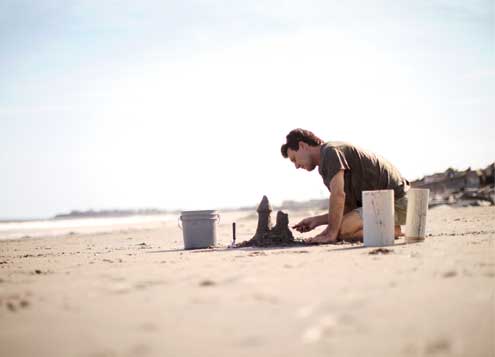Knowledge & Wisdom: How to Build a Sand Castle
The Right Stuff First you need good sand. (For the Hampton competition, Grady trucks in 300 tons of it.) To find out what you’re working with, head to the water’s edge, pick up a handful of sand, and form a ball. “If you can hold it sideways between your thumb and middle finger and it […]

The master, Greg Grady, at work on his hometown beach.
Photo Credit : Kozowyk, ChristianThe Right Stuff
First you need good sand. (For the Hampton competition, Grady trucks in 300 tons of it.) To find out what you’re working with, head to the water’s edge, pick up a handful of sand, and form a ball. “If you can hold it sideways between your thumb and middle finger and it stays compacted,” Grady explains, “you can sculpt that sand.”
Recycle, Reuse
Grady turns paint cans into buckets. Cake-decorating tools are great for sculpting; stainless steel spatulas, too. He also makes some of his own sculpting tools: At big hardware stores he collects scraps of binding wire, cuts them into one-foot strips, then gives one end a 60-degree bend, wrapping the other with duct tape for a handle.
Patty Cake, Patty Cake
Grady is a proponent of the pancake method. You need a “mud bucket,” a container filled two-thirds with sand and mixed with water for a consistency akin to batter. Scoop, dump, form, then repeat. “Pat [the pancakes] down so they’re nice and flat,” Grady advises. “You want them to hold their form even while they’re leaching water.”
Form & Function
Forms can be a sculptor’s best friend. For a simple tower, for example, Grady might use a five-gallon bucket, cut out its bottom, then turn it upside down, filling it with sand and water, which he then pounds down with his foot or a piece of wood. “You want it compact,” he says. To release the bucket, tap its sides gently and lift. For a tapered construction, continue building with smaller and smaller forms.
Bridge to Somewhere
Want to wow your audience? Build a pair of towers close enough so that you can just about get a fist between the two. Keeping your hand in place, cover it with scoops of slurry from your mud bucket. Be careful to hold your fist still, about 30 seconds, until the mixture is dry enough to hold its form. “Then just give your hand a little twist and release,” Grady says. Now you’re ready to sculpt.
Get Sticky
“What really hurts a sculpture are wind and blowing sand,” Grady says. To keep his creations hydrated, he waters them down with a spray bottle. At competitions he’ll go a step further and use a heavily diluted mixture of Elmer’s glue and water. “When I’m done, I’ll go over it and give it a light coat, almost like an M&M shell,” he adds, “then come back after it’s dry and do it again.”
Expect Mistakes
Construction snafus happen to the best of sculptors. And that’s okay. “It always comes out better the second time,” Grady says. “Sometimes I’ll practice and just see how far I can push something before it falls down.”
For photos of this year’s 10th Annual Hampton Beach Master Sand Sculpting Competition, held June 19-30, visit: hamptonbeach.org
Ian Aldrich
Ian Aldrich is the Senior Features Editor at Yankee magazine, where he has worked for more for nearly two decades. As the magazine’s staff feature writer, he writes stories that delve deep into issues facing communities throughout New England. In 2019 he received gold in the reporting category at the annual City-Regional Magazine conference for his story on New England’s opioid crisis. Ian’s work has been recognized by both the Best American Sports and Best American Travel Writing anthologies. He lives with his family in Dublin, New Hampshire.
More by Ian Aldrich

